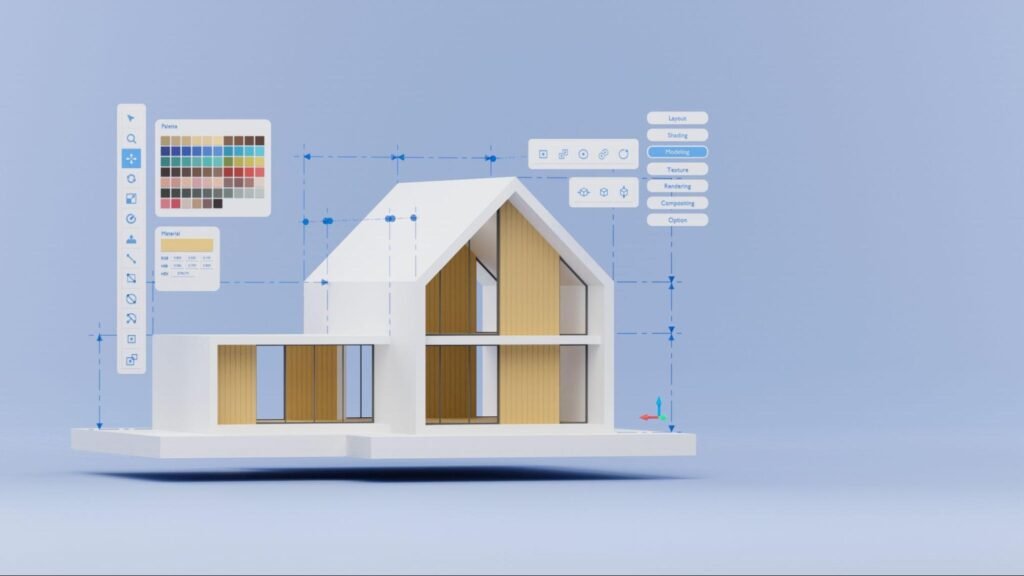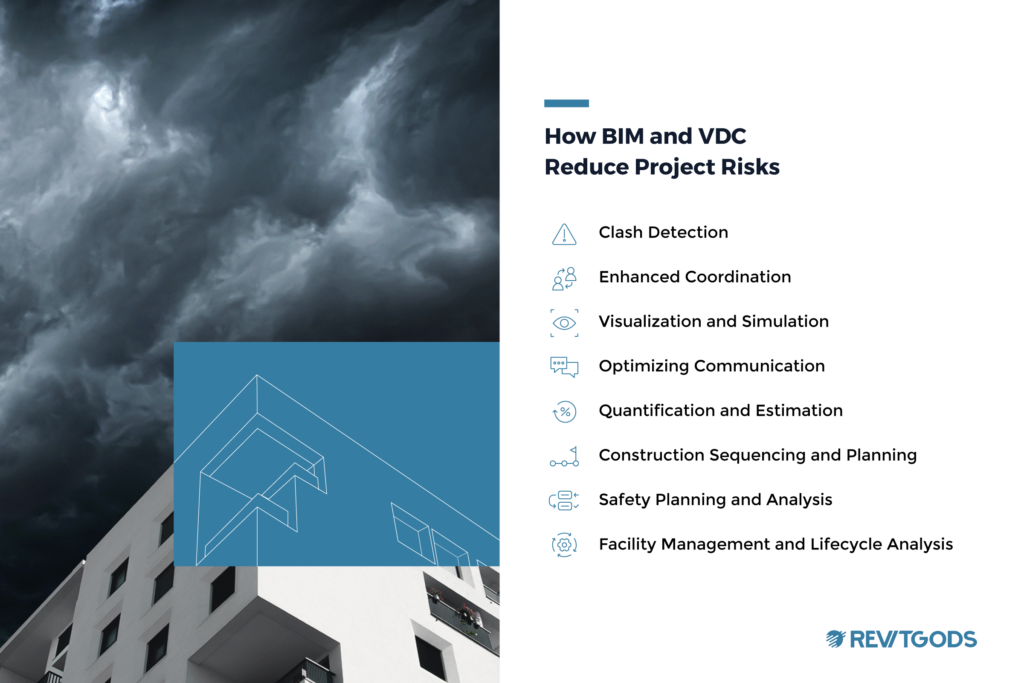BIM, or Building Information Modeling, is the process of creating and managing information within a 3D building model. The BIM process gives architecture, engineering, and construction (AEC) professionals a shared framework to design, plan, and coordinate built assets, ensuring that projects are completed effectively and on time.
BIM managers oversee the development of BIM models. They create the strategy for developing building projects virtually using BIM software and implement it amongst all project stakeholders, troubleshooting any issues that may arise along the way. Although the profession is still relatively new, it is quickly gaining popularity. By 2031, the BIM market could be worth nearly four times its current value.
With such rapid growth in the industry, many people have questions about what BIM management is and how it will impact related jobs in engineering and construction. This article will explain the role of BIM management and explore the exciting potential of this emerging field.

What Is BIM Management?
BIM management involves the management of BIM models throughout the design process. Various consultants — such as architects, engineers, and interior designers — author BIM models, contributing to a single master model that’s used to produce construction documents, coordinate construction, or produce renderings of built environments. It’s a highly involved and collaborative process.
The BIM manager serves as a conductor or overseer that makes sure all content is integrated seamlessly. When done well, BIM models can be used to coordinate entire construction projects virtually to avoid errors and rework or be used by facility managers to manage properties digitally from a single computer.
BIM managers are essential to the success of any development project and are busiest during the initial creation of a model and during key design phases. They can also be heavily involved during construction when they check to make sure a building design is constructible by running clash detection.
BIM managers fulfill various duties on a project:
- Developing BIM Execution Plans and ensuring that team members follow it throughout the project
- Empowering the project teams to produce and collaborate effectively by removing all technical barriers
- Train and coach colleagues in various BIM software platforms
- Providing tools and resources to team members on an as-needed basis
- Implementing any necessary tools and hardware for a project to succeed
- Creating monthly reports for senior managers to analyze their BIM projects and see how they’re performing
- Develop Revit templates and BIM workflows to streamline production
- Troubleshoot issues that arise during the project
- Automate certain components of the design process to speed up analysis, decision-making, and documentation
- Taking the lead on the technical side of the project so that design managers can focus on designing
- Making sure that BIM models capture all elements of an intended design
This is only a snapshot of the vital role that BIM managers play in design projects. Tasks may vary depending on the BIM manager’s unique skill set and the nature of the specific building.
Benefits of BIM Management
BIM management streamlines the design and construction process and brings the following benefits to project teams:
- Better visualization. BIM models offer a data-rich digital twin of a building, helping team members identify issues prior to construction and plan future renovations after the building has opened.
- Collaboration between stakeholders. BIM managers facilitate communication between various parties, improving collaboration and providing opportunities for team members to work together.
- Fewer errors. BIM managers identify design errors before construction begins, fixing issues ahead of time and avoiding costly delays.
- Higher levels of productivity. BIM managers automate simple tasks, improving efficiency and productivity.
- More sustainability. BIM managers use analysis tools to identify ways to reduce energy consumption and optimize systems during the building process, helping with sustainability initiatives..
- Reduced costs. Along with reducing errors, BIM managers can extract material quantities from a model while it’s being designed to help construction managers analyze project costs and find ways to maximize their construction budget.
Challenges in BIM Management
Although BIM management is an important and necessary job, it has its challenges. Understanding these can better prepare your team for such obstacles, possibly avoiding them altogether. Teams that use BIM software may face these issues in their work:
- Lack of standardization. The lack of a standardized process for becoming a BIM manager in the U.S. and the absence of a universal approach to BIM use poses a significant challenge. As a result, BIM managers without direct experience in certain specific realms of building design may need to rely on experimentation and testing.
- Inability to lead. Some BIM consultants and managers know quite a bit about Revit software but little about how to lead an organization through a digital transformation. The best BIM managers possess technical skills as well as the people skills needed to implement new workflows.
- High demand. Many companies are looking for BIM managers right now, and most organizations find it challenging to find (and keep) their top talent.
- Low retention. Most BIM managers will only stay with a company for 2-3 years. It’s common for them to feel overworked and under supported in their role.
- Wide landscape of roles and tasks. BIM management is a broad field, and BIM managers must know how to complete a wide range of jobs.
The Evolution of the BIM Management Industry
BIM traces its roots back to 18th-century France but didn’t emerge more prominently until the 1970s when the American National Standards Institute (ANSI) began exploring different methods for using data. They developed a methodology that the U.S. Air Force soon implemented in their projects. Other organizations took notice, and BIM grew in popularity throughout the rest of the 20th century.
The real rise of BIM has occurred over the last ten years. While 73% of organizations were aware of BIM in 2007, only one in ten businesses reported actually using BIM as of 2011. As technology has improved in recent years, BIM has become recognized as a valuable tool in architecture and construction, and experts anticipate a projected growth rate of 12% CAGR through 2030.
Here are some of the trends that will drive the expansion of BIM during this time:
- Automation. Building designers and owners are seeking to automate parts of the building design process. This digital transformation requires BIM management software to streamline the process and reduce dangerous on-site job risks for workers.
- Cloud software. The rise of cloud collaboration tools is enabling design teams to work together on a single 3D BIM model together. This gives them easy access to the data, servers, and software they need to collaborate efficiently.
- Digital twins. Today’s building owners want a digital twin of their property once it’s completed that they can use to streamline future building renovations and facilities management.
- Sustainability. BIM models let designers conduct accurate energy analyses to predict future building performance. Considering that buildings contribute to over 50% of carbon emissions, accurate building energy modeling (BEM) is critical for addressing public interest in reducing their carbon footprint.
- Project oversight. The design-build project lifecycle delivery method puts general contractors at the front of the design process. They use BIM early in design to plan out material costs, manage lead times, and develop construction schedules.
Key Players in the BIM Industry
BIM management impacts building owners, architects, engineers, and general contractors in unique ways. Each field can benefit from the functionality and capabilities of BIM. Let’s look at how different professionals and stakeholders approach BIM and implement the technology into their work.

Building Owners
Building owners set the BIM requirements that everyone on a project is meant to follow. They want a digital twin of their finished building that they can use for future renovations and facilities management.
Architects and Engineers
Architects and engineers Architects and engineers are typically the first to respond to building owners’ requirements by authoring the BIM models for the project. They create the sketches that serve as the foundation for the project as a whole, and they include important details such as dimensions and performance traits. They must confirm with other stakeholders that all designs meet project requirements and expectations.
They also assist in quality assurance and optimization by eliminating errors, resolving inconsistencies, ensuring compliance with various regulations and BIM standards, seeking out areas of potential improvement, and implementing new technologies when relevant.
General Contractors
General contractors and their fabrication teams make further edits to BIM models during the planning and coordination phase. They make further enhancements to BIM models by swapping out generic model elements for more specific ones so they can more accurately plan and coordinate construction, streamlining workflows. They’re also responsible for using the BIM model to plan and coordinate their projects to reduce errors and rework on site.
Construction companies are truly responsible for creating the final digital twin that gets handed off to the building owner. All installed building products and changes that occurred during construction must be represented in the final BIM model.
BIM Service Providers
These providers (including RevitGods) manage the entire process. They interpret the BIM requirements developed by the building owner, communicate them to the project design team, facilitate training, develop any necessary content, and manage the BIM deliverables for the entire project.
They also work with general contractors to ensure all changes to the BIM model are reflected in the field, help run the BIM coordination process, and ensure that the final model is the true digital twin that the building owner is expecting.
In short, the design and construction teams get to focus on doing the things they’re great at, while BIM service providers like RevitGods handle all of the technical details for the entire life of a project.
Applications of BIM Management
The applications of BIM management are numerous and significant. You’ll find relevant examples below to help you understand how BIM project management can take your projects and designs to the next level.

BIM Management in Building Planning and Design
BIM Management is helpful in building design and planning, especially during the early stages of a project. Your team can access realistic 3D models through BIM management before construction begins. You can spot potential flaws and optimize the design to improve energy efficiency and reduce costs.
BIM designs can also reveal conflicts between plumbing, HVAC, and electrical systems. Identifying these issues ahead of time eliminates the need to rework existing systems later in the process, which often causes construction delays.
In addition, BIM management serves construction planners and design teams by allowing for schedule optimization. BIM software can simulate the construction process, helping teams discover potential schedule conflicts and delays.
BIM Management in Construction Management and Coordination
Construction managers use BIM models to communicate design intent clearly and effectively with various stakeholders. Using detailed 3D BIM models, they run various simulations to identify potential issues that may occur during construction. Teams can share and review all information to ensure everyone is on the same page.
BIM management also helps construction managers make project schedules more accurate and easier to track in real time. They can look at the BIM data and identify risks to the project’s schedule, then make necessary changes to keep the project on track.
Construction managers also use BIM’s safety analysis tools to identify potential safety hazards and injury risks.
BIM in Facility Management
Some property managers use BIM after construction to optimize energy use and track various data points.
BIM managers work side-by-side with facilities managers to teach them how to use BIM models to manage their properties. They typically train facilities teams, and implement software and tech to give maintenance crews access to BIM model data on their phones or tablets. This allows them to easily find important information so they can make repairs and update BIM models throughout the life of a building.
BIM managers can also work with facility managers to track and plan building performance. For example, they can help manage the digital twin platforms that show how much energy a property may be consuming at any given time.
The Future of BIM Management
The BIM industry was valued at $6.6 billion in 2022 but should exceed $10 billion by 2026. The primary reason is the increase in design-build construction. With design-build contractors as the master builders, they’re the ones leading projects from design through construction. Design-build contracts position general contractors at the beginning of the design phase, allowing them to pick materials, determine product lead times, and plan their construction process while their design team designs the building.
BIM has huge benefits to the construction process, since it’s able to help contractors estimate material quantities much faster, simulate a construction schedule against weather patterns, and coordinate the design prior to the start of the construction phase. It’s even required in most U.S. metropolitan areas and large companies. Since general contractors at the beginning of the process are increasingly using BIM, more architects are forced to adopt it as well.
Over the next several years, building owners who want a digital twin at the end of their projects will drive BIM adoption. Building owners who want to streamline their facility management efforts and push towards a more digital future will continue to drive the BIM market up.
With BIM emerging as the industry standard, not only will all new building projects implement BIM into the design and construction process, but BIM will also be a bigger player in how buildings are managed in the future. Property owners will soon be able to manage their entire portfolio from a single computer, spitting out building performance and usage data in just a few clicks.
BIM technology presents incredible potential, but many components are still underutilized. This should change over time as technology improves and adoption becomes more standard.
In the meantime, the cost of training and the high pricing of services will continue to be a challenge in the BIM industry. The slow speed of industry standardization also slows down the influx of new BIM managers into the market. The traditional slow implementation of software into professional construction is another obstacle the BIM industry must overcome.
But with time, all of these challenges can be overcome — making BIM invaluable to the industry.
Stay Ahead of the Curve With RevitGods for BIM Management
Although BIM management is still developing and emerging, it has a bright future and the potential to impact the building design and construction industry significantly. BIM managers will continue to become more and more necessary in the AEC world, and hiring managers should strongly consider the value of partnering with a dedicated and established BIM management team — like RevitGods.
If you’re an AEC business owner or hiring manager looking to save time and money on an upcoming project, maximize your time and resources on your upcoming project by utilizing the comprehensive BIM services provided by RevitGods. By partnering with RevitGods, you can confidently delegate the technical aspects to the experts, allowing your team to dedicate more time to what they do best. Turn our superpower into your secret weapon.





